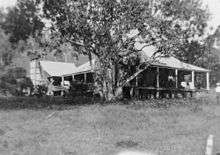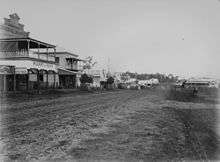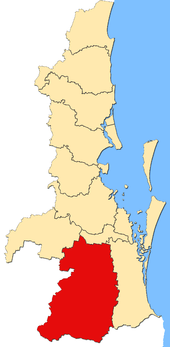Beaudesert, Queensland
| Beaudesert Queensland | |||||||
|---|---|---|---|---|---|---|---|
|
Main street of Beaudesert | |||||||
 Beaudesert | |||||||
| Coordinates | 27°59′0″S 152°59′0″E / 27.98333°S 152.98333°ECoordinates: 27°59′0″S 152°59′0″E / 27.98333°S 152.98333°E | ||||||
| Population | 5,999 (2011 census)[1] | ||||||
| Established | 1870s[2] | ||||||
| Postcode(s) | 4285 | ||||||
| Elevation | 50 m (164 ft) | ||||||
| Location | |||||||
| LGA(s) | Scenic Rim Region | ||||||
| State electorate(s) | Beaudesert | ||||||
| Federal Division(s) | Wright | ||||||
| |||||||
Beaudesert is a town and locality in the Scenic Rim Region, Queensland, Australia.[3][4] At the 2011 Australian Census the town recorded a population of 5,999.[1]
Geography
Beaudesert is located on the Mount Lindesay Highway, some 91 kilometres (57 mi) south of Brisbane. The area sources its income predominantly from rural activities such as cropping, grazing and equine activities, as well as tourism. It boasts a racecourse, 50-metre swimming pool, public library, two gyms and mountain scenery.
From the nineteenth century through to the nineteen eighties it was a thriving centre with a shoe factory and meat works as well as markets, a hospital and an ambulance service. The Enright family [5] managed a major department store. The Blunck family managed an electrical store and car servicing and sales business.[6] As in many areas, globalisation has seen local factories and family owned business taken over and closed with profits leaving the town where once they would have been reinvested.
In the Logan River and Albert River valleys, Beaudesert is a regional hub serving surrounding communities such as Rathdowney, Kooralbyn, Canungra, Tamborine Mountain and Jimboomba. It is approximately 91 kilometres from Brisbane and connected by the Mount Lindesay Highway.
The town of Beaudesert is located 46 m above sea level and has an average annual rainfall of around 916 mm per year. The temperature is around thirty degrees in summer and falls to around three degrees in winter. Generally the weather is mild but some severe storms arrive each summer.
In the east of the locality is the decommissioned Nindooinbah Dam. The much larger Wyaralong Dam is situated roughly 14 km to the north west of the town and was completed in 2011.
History


The town was settled in 1847 and has grown to a small, bustling centre.
The town is possibly named after Beau Desert Park, the property of Charles Henry Alexander Paget, 6th Marquess of Anglesey in Staffordshire, England.[2] Yet it is certain that Queensland's Beaudesert was named in about 1841 or 1842 by 'Ned Hawkins', or Edward Brace Hawkins (1821–1849), who was claiming the area as a sheep station on behalf of his employer William Henry Suttor senior (1805–1877) at Bathurst. It is not known why Hawkins picked the name Beaudesert. He was himself born in Newark Upon Trent in Nottinghamshire, the son of Thomas Fitzherbert Hawkins and wife Elizabeth of Bathurst fame, and it does not seem that he or his family had any personal connections to Beaudesert in England. Ned Hawkins moved on, not long after taking up Beaudesert station, to take up Boonara Station in the South Burnett.

The town was originally set out in a grid pattern; however, several of the streets followed cart tracks. The area was originally settled for growing cotton and sheep. However, the area is also notoriously short of water and the cotton was not a successful crop. Hoop pine was very successfully collected from the area. In 1863 the cotton workers were indentured labourers from the South Sea Islands, the first such use in Queensland. In the 1880s, the Cobb and Co coaches ran between Beaudesert and Jimboomba. In 1885, the Beaudesert railway line was being pegged out and the railway was opened in 1888. Timber, cattle and dairying were the main industries in the area.
The Beaudesert Shire Tramway to Christmas Creek, Lamington and Rathdowney, operated by the Beaudesert Shire, opened in 1903 and closed in 1944. A local newspaper, the Beaudesert Times was established in 1908.[7]
Even though the area was known as Beau-desert (beautiful desert), the droughts and the floods were continuous problems in the area. In times of flood, houses, animals and people were washed away. The damage caused by floods is often recounted in historical documentation.
The Biddaddaba History Group brought together the history of the area from the earliest settlement of white people up to 1990 in a comprehensive book available from libraries.[8]
Located in the Beaudesert Historical Museum is the Milbanks Pioneer Cottage. This cottage was originally built in 1875 by Patrick Milbanks on his Kerry property, out of local hand hewn timbers, slats and shingle roof. It has four-poster bed, large cedar sideboard and numerous articles that portray the life of the early pioneers. It was donated to the museum by Patrick Milbanks's grandchildren and relocated to its present site in 1979.

The Beaudesert War Museum was unveiled on 28 September 1921 by Queensland Governor Matthew Nathan.[9]
| Year | Event |
|---|---|
| 1842 | Nindooinbah was settled |
| 1850 | Nindooinbah original homestead was built |
| 1885 | Beaudesert Hotel (burned down in 1940 and replaced) |
| 1901 | St Marys Primary School opened. |
| 1903 | Beaudesert Shire Tramway opened |
| 1904 | The Logan and Albert Co-operative Butter Factory opened and closed 1987. |
| 1919 | Beaudesert RSL Sub Branch in Jane Street |
| 1927 | Visit by The Duke and Duchess of York |
| 1934 | L & A Hotel opened |
| 1944 | Beaudesert Shire Tramway closed |
| 1964 | Beaudesert High School |
| 1993 | A J Bush. Destroyed by fire in 2001. Reopened in 2002 |
| 1995 | Gelita opened |
Heritage listings
Beaudesert has a number of heritage-listed sites, including:
- Albert Street: Beaudesert Showgrounds[10]
- 7-9 Albert Street: St Thomas’ Anglican Church[10]
- 3180 Beaudesert-Boonah Road: Beaudesert Racecourse and Grandstand[10]
- 33 Brisbane Street: Beaudesert Masonic Centre[10]
- 80 Brisbane Street: Beaudesert Hotel[10]
- 82 & 84 Brisbane Street: Scenic Rim Regional Council Chambers[10]
- Bromelton Street: St Mary's Catholic Church[10]
- William Street: Beaudesert War Memorial[11]
Council

The Tabragalba Divisional Board was incorporated on 11 November 1879 under the Divisional Boards Act 1879, centred on Beaudesert. With the passage of the Local Authorities Act 1902, Tabragalba became a shire council on 31 March 1903, and on 8 August 1903 was renamed Beaudesert by an Order in Council. Between 23 November 1912 and 14 September 1929, a separate Beaudesert Town Council managed the town itself.
On 9 December 1948, an Order in Council abolished the Shires of Nerang, Tamborine and Waterford and included the latter two and part of Nerang into a new Shire of Beaudesert. Waterford had existed largely unaltered since being created as a Divisional Board in 1879, while Tamborine (spelt Tambourine until 14 January 1939) had split away from Tabragalba on 4 October 1890. The Shire of Beaudesert was split into four divisions with a total of eight councillors-Division 2 with four, Division 4 with two and the others with one each. The chairman (later Mayor) was to be chosen from amongst the councillors. The new council was formally established at elections on 31 May 1949 and a Special Meeting was held on 7 June. It had grown 40% in population and gained 1,045 km2(403 sq mi) in the process.
On 8 June 1978, the Shire of Logan was created out of parts of Beaudesert and the Shire of Albert. The council lost 146.1 km2 (56.4 sq mi) of its area and 11,550 people to Logan. At the 1979 council elections, Beaudesert was resubdivided into eight divisions each electing one councillor.
On 15 March 2008, under the Local Government (Reform Implementation) Act 2007 passed by the Parliament of Queensland on 10 August 2007, Beaudesert was abolished and became one of only three Queensland councils, alongside Taroom and Tiaro, to be split in two. The Scenic Rim Regional Council was born. The northern area, which while still largely rural was part of Brisbane's growth corridor, became part of Logan City, while the southern rural section became part of the Scenic Rim Region alongside the Shire of Boonah.
Beaudesert Shire Council building now houses the Scenic Rim Region Council. There are 6 Councillors and a Mayor for an area of 4,238sq km and a regional population of 38,000.
Bromelton State Development Area
Bromelton SDA was declared in 2008, and covers 15,000 hectares of land approximately six kilometres west of Beaudesert. About 1,800 hectares has been earmarked for industrial development. It will accommodate industrial activities of regional, state and national significance, maximising the use of the areas existing standard gauge rail. The railline connects Bromelton to the Port of Brisbane, to other parts of Queensland, and to other States.
Mirvac has commenced work on a site bordered by Sandy Creek Road and Beaudesert Boonah Road. The Bromelton SDA applications will be reviewed by the Co-ordinator General for approval. The Scenic Rim Regional Council will be responsible for operational works, clearing of vegetation, plumbing and Reconfiguration of Lots (ROLs) applications after the MCUs have been approved by the State Government.
Schools
Beaudesert Special School, Beaudesert State Primary School, Beaudesert State High School, Mcauley College Beaudesert, St Marys Catholic School, as well as pre-schools and childcare centres.
Population
| Year | Population |
|---|---|
| 1881 | 25 |
| 1891 | 450 |
| 1911 | 1,330 |
| 1947 | 1,548 |
| 1961 | 2,930 |
| 1991 | 4,028 |
| 2001 | 4,460 |
| 2006 | 5,388 |
| 2011 | 6,000 |
Bus
A bus runs from Beaudesert to Browns Plains and Brisbane on weekdays. Centacare St Mary's Community Services and the Beaudesert RSL provide transport for aged, disabled, veterans and hospital/respite requirements.
Rail
The main standard gauge Brisbane-Sydney railway line runs through Bromelton, a few kilometres west of Beaudesert. This line is used by Countrylink's Sydney-Brisbane XPT passenger train and Pacific National's (owned by Toll and Lang Corp) Brisbane – Sydney, Brisbane – Melbourne, Brisbane – Wollongong and Brisbane – Adelaide and return freight train services. The passenger service no longer stops at Bromelton.
A branch railway line ran from the outer Brisbane suburb of Bethania to Beaudesert and was in regular use from 1886 to 1996. Until 1991 it had served the meat-packing plant on the outskirts of the town.
A petition from railway enthusiasts, and considerable grants of government money, resulted in its re-opening in 1999. Beaudesert Rail operated steam-driven tourist trains on the line for a short while thereafter. The company ceased operating in August 2004 after a series of fires, allegedly lit by sparks from the train, were set along the train line. The company was in debt and has ceased to exist, with the rolling stock liquidated and physical infrastructure demolished. Beaudesert Rail had also been trading while insolvent, resulting in the closure of several local business who had extended them credit.
Community Groups
The Arts Centre hosts a number of community groups and there is a wide range of community activity including a very active Bush Bards group.[12]
Sport and recreation
A number of well-known sporting teams represent the local area, including the Beaudesert Kingfishers who play home games at R.S. Willis Park.
Notable residents
Neville Bonner, the first indigenous Australian to become a member of parliament, attended Beaudesert Primary School.[13]
Jason Day, a leading PGA golfer who won the 2015 PGA championship, was born in Beaudesert. His father, Abby (Alvyn) Day was also born in Beaudesert but he died due to cancer when Jason was 12 years old. Jason's mother sold the family home to send Jason to Kooralbyn secondary school near Rathdowney as a boarder and then, when this school closed to Hills Academy where the school had a golf course. (Adam Scott, also an Australian golfer, also attended Kooralbyn). Col Swatton was a teacher at Koralbyn and became Jason's caddie in a partnership which took them to the PGA win. Jason's first set of golf clubs was given to him when he was 4 years old by his father who found them at the local tip.[14]
Marilyn Leask, professor of education, was born in Beaudesert and attended the primary and high schools. She is descended from pioneering families who migrated from the UK in the middle of the 19th century.
Harry McVey [15] who emigrated from Falkirk in Scotland to Australia with his family in 1910 was well known in the district for his poetry, painting and accordion playing. He died aged 97 in 1995. His book of poetry and paintings is available at the Canungra Tourist Centre.
George Mavor and his wife Agnes moved from Brisbane to Beaudesert in 1941 where for 40 years he was a teacher. He was the Organising Secretary for the National Fitness Council and instrumental in the establishment of a National Fitness Camp at Lamington at the end of the Christmas Creek Valley and in a camping program for young people in Beaudesert. Generations of school children were introduced to the border ranges and walking and living in the bush through the August School Camps. Mavor Park recognises their contribution to the lives of the young people of Beaudesert. Two of their sons became Methodist/Uniting Church Ministers. John became President of the Uniting Church in Australia and Ian was the Master of Kings College Queensland and later established a Hospice on the Gold Coast in Queensland.
Rick Price, musician, was born in Beaudesert.
Queensland and Brisbane Broncos player Andrew Gee was born in Beaudesert.
Pauline Hanson, leader of One Nation
See also
References
- 1 2 Australian Bureau of Statistics (31 October 2012). "Beaudesert (State Suburb)". 2011 Census QuickStats. Retrieved 16 April 2014.
- 1 2 Queensland Environmental Protection Agency (2000). Heritage Trails of the Great South East. State of Queensland. p. 28. ISBN 0-7345-1008-X.
- ↑ "Beaudesert (entry 1995)". Queensland Place Names. Queensland Government. Retrieved 28 March 2014.
- ↑ "Beaudesert (entry 45109)". Queensland Place Names. Queensland Government. Retrieved 28 March 2014.
- ↑ "Beaudesert - Queensland Places". queenslandplaces.com.au.
- ↑ "Pictures of Australia from 1927". bonzle.com.
- ↑ "About us". Beaudesert Times. Beaudesert Times. Retrieved 16 June 2014.
- ↑ "The history of Biddaddaba Creek, Boyland, Canungra Line, Queensland". nla.gov.au.
- ↑ "Beaudesert War Memorial (Digger)". Queensland War Memorial Register. Retrieved 3 April 2014.
- 1 2 3 4 5 6 7 "Local Heritage Register" (PDF). Scenic Rim Regional Council. Retrieved 9 February 2015.
- ↑ "Beaudesert War Memorial (entry 600028)". Queensland Heritage Register. Queensland Heritage Council. Retrieved 12 July 2013.
- ↑ "Community groups". beaudesertartsandinfocentre.org.au.
- ↑ "Neville Bonner - Fact sheet 231 – National Archives of Australia". naa.gov.au.
- ↑ Source: local sources and Courier Mail 18/8/15.
- ↑ "Beaudesert memories / by Harry McVey - National Library of Australia". nla.gov.au.
External links
| Wikimedia Commons has media related to Beaudesert, Queensland. |